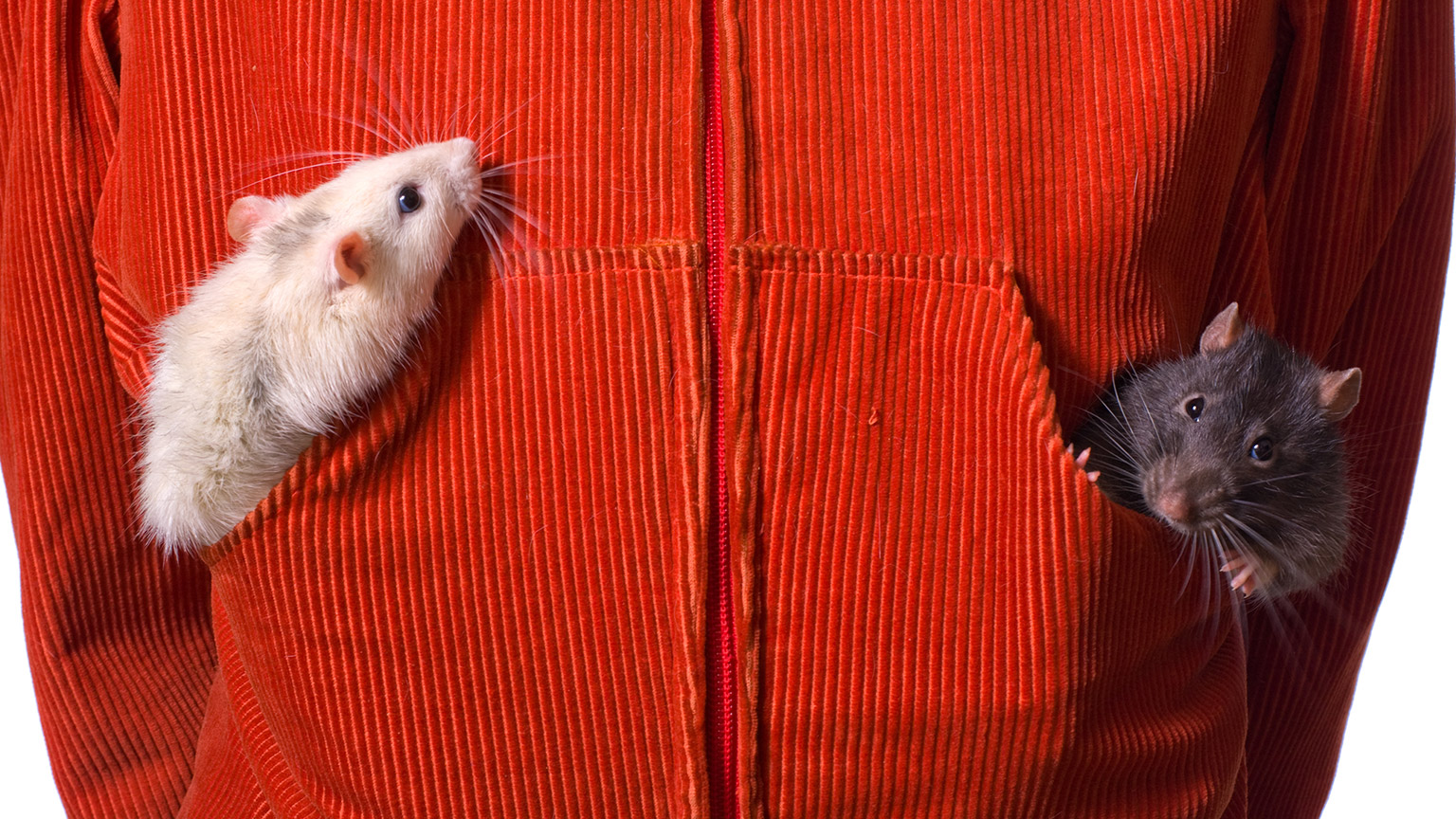A pocket pet is a small mammal kept as pet and usually includes rats, mice, guinea pigs, hamsters and gerbils. Hamsters and gerbils are not common in New Zealand, so we won’t be talking about them here. First we’ll take a quick look at how rats, mice and guinea pigs came to be domesticated and share their lives with humans as companion animals. Then we’ll look at:
- Coat types and colours
- Breeds

All domestic rats are descended from the wild Brown rat (Rattus norvegicus). Domestication happened around 200-300 years ago in both Europe (where rat baiting was a popular sport), and in Japan where wealthy nobles kept rats as pets.
Fancy rats, as domestic rats are often called, come in a range of colours and coat textures and two ear positions. Many of the words used to describe coat colour and pattern will already be familiar to you from the dog, cat and rabbit topics. Fancy rats are very sociable and function best with at least one cage mate. It is a bad idea to keep a single rat unless it has shown that it is unsociable in personality.
In the context of fancy rats, the word ‘breed’ means something different when talking about rats than it does for cats or dogs. A ‘breed’ of cat or dog implies a pedigree of traits that includes common physical and temperamental characteristics. In rats it only refers to physical characteristics, and often the word ‘variety’ of rat rather than ‘breed’ is used. Variety includes:
- Smooth or curly coat
- Coat markings
- Ear shape
- Fur colour
Fancy rats will have a mix of these traits and can belong to more than one variety.
Varieties
- Standard rat – the basic form of the rat which is sometimes a pet and sometimes used in laboratories.
- Dumbo rat – has large ears on the side of its head instead of on the top as per the Standard rat form.
- Hairless or Sphynx rat – has no hair except for around the mouth and cheeks which is very fine.
- Rex rat – has crinkly, wooly fur and whiskers.
- Satin rat – has a soft and shiny coat.
- Tailless rat/Manx rat – has either no tail, or a very short tail.
- Topaz rat – has a warm coloured fawn or golden coat.
- Bristle Coat rat – has coarser hair in the coat, which also tends to stand on end rather than lie flat.
- Dwarf rat – a relatively new variety, which is much smaller than the Standard rat.
Rat Coat Types
Unlike cats, dogs and rabbits, rats do not have much variety in their coat types. One difference is that females tend to have softer fur to touch than males who tend to have thicker and rougher hair. We have actually already covered the coat types in our discussion above of ‘breed’ versus ‘variety’, but to make it clear they are:
- Hairless
- Rex
- Satin
- Standard
Rat Colours
There are two basic colour options for rat coat colours: agouti and black, with white (albino) also being an option in the absence of a colour gene. This is very similar to rabbit colouring. From these two base colours and white there many different shades and patterns. Like rabbits, eye and coat colour are linked in rats.
Agouti Colours
- Standard agouti with bands of dark and light on individual hair strands
- Cinnamon (warm reddish brown)
- Fawn (light ginger brown)
Black Colours
- Black
- Brown/Chocolate
- Beige
- Blue (gray)
- Cream or champagne
Coat Patterns in Rats
Self – the rat is one solid colour over the entire body.
- Any Other Colour (AOC) – this is another way of saying ‘type of agouti’ where hairs have bands of colour. The base colour is the same over the entire body though. For example Blue Agouti versus Brown Agouti.
- Any Other Color Pattern (AOCP): a combination of two or more colors other than white. For example some patterns resemble the markings of Siamese Cats with cream fur and dark noses and paws.
- Silvered – white hairs are sprinkled through a coat with a darker hair base.
- Marked – spots, stripes, and patches of either white or a different colour. Some of these marks or patches look like hoods, or caps or lightening blazes on the rat’s head.
Activity
Try this timed quiz on the features of fancy rats: (Some) Fancy Rat Varieties Quiz.
The link will take you to another website and you shouldn’t need to sign in to play the quiz. Just click the start arrow in the middle, and the question will appear in the bar at the top. You select your answer by clicking the small coloured dot on each picture.
Before you click start, take a moment to read the caption on each picture – as they will give you some clues to answering the questions!
Rat Form and Function
Although fancy rats are descended from Rattus norvegicus, and cross breeding between the wild Brown rat and domestic rats is possible, fancy rats are physically and temperamentally different to their wild relatives. They have smaller bodies, larger ears and longer tails, and smaller faces with sharper and more pointed features than the wild rat. Fancy rats live longer than wild rats, while wild rats have larger brains and internal organs. Fancy rats also have different health issues, and don’t carry diseases that can harm humans like wild rats can. All of these differences most likely due to both breeding selection and responses to living conditions.
Temperamentally fancy rats are regarded as having traits that make them excellent pets, which may surprise some people who associate them with many of the unattractive traits of wild rats. They are social, intelligent, and easy-going animals that are really happy to be handled by humans. They can be trained to perform tricks and have a strong homing instinct to return to their cages so won’t often go missing or become lost. Although they have a strong bite, they generally don’t - they tend to be calm animals that don’t alarm easily. Rats are ideal pets for working people, because they are predominantly active in the mornings and evenings. They make better pets for older human children rather than younger, because young children do not have fully developed motor skills and may accidentally hurt rats when handling them.
Fancy rats retain many of the features of their wild ancestors. Like all of the other animals we have investigated in this module, the body structure of rats matches with their original wild functions. Rats are omnivores who play a part in keeping ecosystems clean by eating pretty much anything. They are also a prey animal. Like many prey animals they are either crepuscular or nocturnal (for safety) and have features that help them exist in dark, small places. Fancy rats will have the following:
- Two upper and lower incisor teeth that never stop growing. This is a survival thing – the kinds of foods that rats naturally eat often have very hard outsides (for example, nuts and seeds). If their teeth didn’t grow quickly then they would wear down and the animal would starve to death. Your fancy rats will always need something to chew on.
- Very sensitive whiskers to help them move in dark places.
- Strong flexible bodies for climbing and squeezing through small spaces (to hide from predators).
- A long, strong tail for balance when climbing.
- Eyes adapted for seeing in the dark (they don’t see well in daylight).
- Excellent hearing (for escaping predators) and a well-developed sense of smell (for navigation and finding food).
- A cautious nature (for avoiding predators), compared to mice.
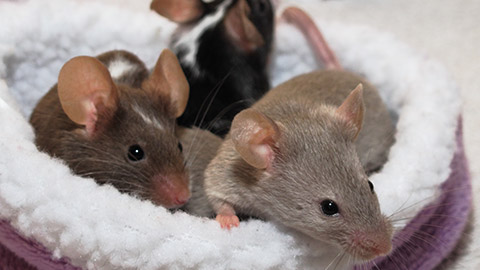
Mice have been living closely to humans since the agricultural revolution (15,000 years ago) when humans started storing the kind of food that mice like to eat. Some scientists have even suggested that wild mice self-domesticated to have traits that would allow them to live closer to humans in order to have access to shelter and stored grains. Modern domestic mice are descended from this wild house mouse (Mus musculus). Mice may have been kept as pets in China as long as 3000 years ago. In the 1700s varieties of domesticated mice were introduced into Europe from Japan and China where they had become popular as pets.
Fancy mice make great pets for the same reasons that rats do, with a few small (pun intended) differences. They are curious (where rats are cautious) and social and tolerate being handled once they become used to their human owners. Females make better pets than males as males may fight each other. They rarely bite their human owners, and if they do it is a sign that they have not been handled properly. Although they are small and should be handled carefully, they have strong bodies that are capable of jumping and climbing. They are not ideal for small children due to their delicate skeleton and tendency to startle and run away if they feel scared. Fancy mice are more aggressive in nature than fancy rats – which may also be a way of protecting themselves against predators.
Mice breeds, coat types and colours are almost (with a few differences) the same as for rats. Like rats, we also used the term ‘fancy mouse’ to distinguish them from their still closely related wild counterparts. As also with fancy rats, breeders tend to talk more about ‘varieties’ than ‘breeds’ of fancy mice.
Fancy Mouse Varieties
- Standard Mouse
- Satin Mouse
- Long Hair Mouse
- Curly or Wavy Hair (Rex) Mouse
- Hairless Mouse
Mice Coat Types
Like Fancy Rats, the coat type is described in the ‘variety’ of fancy mouse. Coat types therefore are:
- Standard Mouse – has short, smooth, flat lying hair.
- Satin Mouse – has short, smooth and very shiny hair.
- Long Hair Mouse – has long, fine and silky hair.
- Curly or Wavy Hair (Rex) Mouse
- Hairless Mouse
Hair types are either ‘over-hairs’ (longer, external hairs for protection) or ‘under-hairs’ (downy hairs for warmth).
Mice Colours
Fancy Mouse colours are either based on a black pigment or a yellow pigment (sound familiar?), with white (albino) colour occurring in the absence of the colour genes. One difference between rats and mice that is (due to a longer history of breeding than rats) is that the colour groupings are either: agouti, yellow or black.
Yellow Colours
The gene that causes the yellow colour base is interesting because the non-dominant form of the gene is lethal, meaning if a mother mouse and a father mouse pass the non-dominant genes to offspring, the offspring will die. The dominant form of the gene produces a yellow coat colour that has several shades.
- Fawn (ginger)
- Cream
Agouti Colours
- Dark brown with lighter colour bands on individual hairs in a uniform pattern across the body
- Cinnamon (reddish brown with agouti banding)
- Silver (grey with lighter agouti banding)
Black Colours
- Black
- Chocolate
- Blue
- Champagne
- Silver
- Sepia
- Burmese
- Beige
Coat Patterns in Mice
- Self – the coat is one solid colour over the whole body.
- Tan – the belly/underside is a tan colour and the top of the body is another colour.
- Marked – another colour with combinations of white in various patterns.
- Satin - highly glossy coat with a metallic like sheen which comes in a variety of colours.
- AOV: Any other variety.
This website has some very good pictures showing the different coat patterns and colours found in Fancy Mice: Pet Mice Breed & Varieties: What Type of Mice Are Your Pets?
Watch: Meet My New Fancy Pet Mice (1:39 Minutes)
This video shows five different varieties of mouse that one mouse owner has.
Post-watch task
Complete the activity below using the video to help you answer the questions.
Mice Form and Function
Many of the points that we made about rats apply to mice: they are prey species that help clean up excess plant-based food sources. They are crepuscular or nocturnal (to avoid predators) and have small, strong and very flexible bodies. Fancy mice will all have:
- Large ears that can move independently from each other for listening for danger.
- A pointy nose with a strong sense of small (for food, location and sensing danger).
- Sensitive whiskers for moving around in the dark.
- A good sense of balance for climbing, which their long tail helps them with.
- A flexible, delicate skeleton, including having no collarbone, for squeezing through tiny spaces.
- Good panoramic vision at night due to eyes on the side of their heads, but poor spatial vision which means they could misjudge spaces and fall and hurt themselves. They don’t see well during the day.
- Teeth that never stop growing, due to the kinds of foods that they eat.
- Can move very quickly – pretty much their only form of defence against predators.
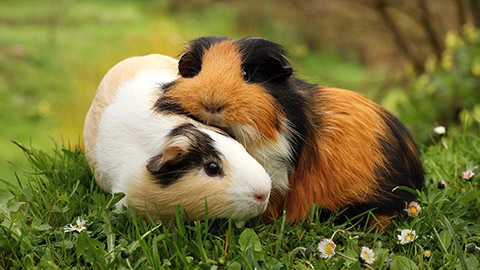
Guinea pigs, Cavia porcellus, are domesticated animals that do not exist naturally in the wild. DNA analysis suggests that their nearest wild ancestor is Cavia tschudii, although they are not direct descendants of this wild species. Domestication may have started around 5000 BC, according to research from the University of Otago (stuff.co.nz, 2023).
Guinea pigs are often known by the name ‘cavy’ are also called ‘cuy’ in their native South America. They were most likely bred for their meat and became popular as pets as early as the 16th century when they were introduced to Europe and North America.
These sweet animals make very good-natured pets that rarely bite and will live for up to 10 years. They are extremely social animals that do best with other guinea pigs. Unlike rabbits, rats and mice, guinea pigs make great pets for small children due to their robust bodies. It’s important to remember that they are descended from prey animals so will frighten easily – they have a freeze or flight response when they are scared. Like the other rodents we have investigated they are naturally crepuscular or nocturnal and will be less active during the day.
Male guinea pigs are known as boars, females as sows, but babies are not piglets! Instead they are called ‘pups.’
Guinea Pig Colours
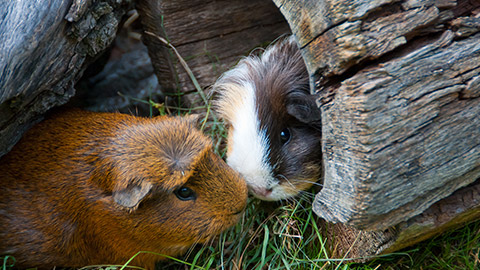
Coat Colours
There are no surprises here with the coat colours for guinea pigs as they are very similar to the other small companion pets that we have looked at in this module. Hair is either black-based or red-based. The colours are:
- Self – one solid colour.
- Ticked – black base hairs with red tips (see the picture above: the guinea pig on the left is ticked).
- Agouti – hairs have bands of dark and light colours.
- Brindle – a mix of black and red hairs.
- Magpie – a type of brindle with white hairs instead of red.
Coat Patterns
As with coat colours the patterns found on guinea pig coats are similar to our other small companion animals. The naming conventions are a little different:
- Dutch pattern – a white pattern: white blaze on the face, with a white neck band and white belly and paws.
- Himalayan pattern – white body with coloured ‘points’ (face, ears and feet).
- Tan pattern – solid black body with red ticking around the muzzle, eyes, under the neck and lower flanks of the body.
- Otter and Fox – yellow ticking on a colour base for Otter and white ticking on a colour base for Fox.
- Tortoiseshell – black and red patterns, with tri-colour types including white.
- Roan – has white hairs interspersed with a different colour base.
- Dalmatian – has a white body with coloured spots.
Guinea Pig Coat Types
Guinea pig breed groups are determined by their coat types:
- Smooth coat
- Long coat
- Rough coat
- Hairless
Other features of guinea pig coats include:
- Rosettes – where the hair forms a swirl on the body.
- Ridges – where the hair stands up on the body like a ‘mohawk’.
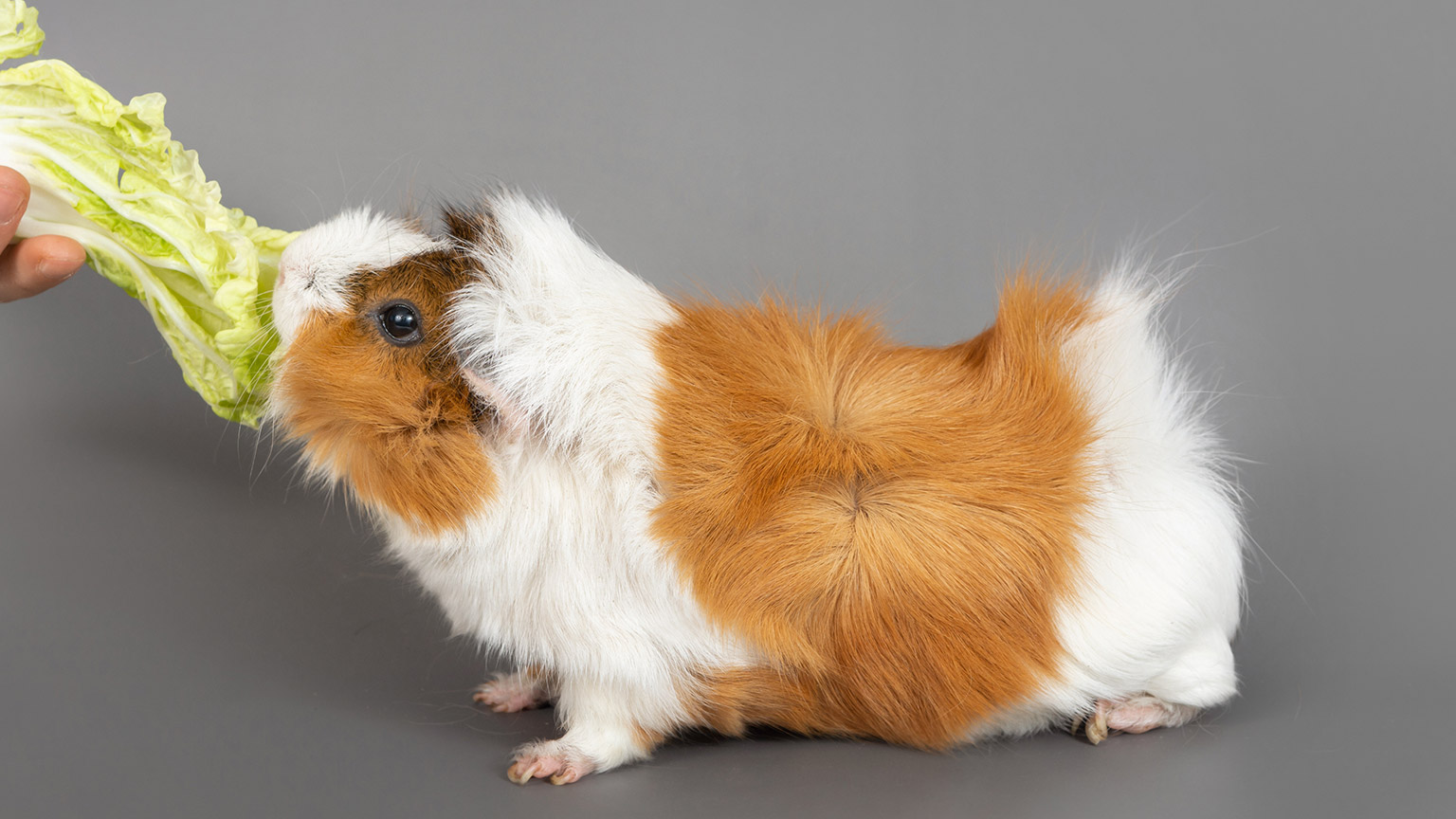 |
 |
| Guinea pig with a ‘rosette’. | Guinea pig (left) with a ridge and a rosette. |
Smooth Coat Breeds
In America, the smooth coat breeds have hair that is less than 2.5 cm, while in Europe breeders include some breeds that have hair up to 6 cm long. Common breeds include:
- American Short-haired Guinea pig
- Crested Guinea pig
- Ridgeback Guinea pig
Long Coat Breeds
The fur of long coat breeds grows continuously, meaning that they are challenging pets to maintain and are not suitable for warm climates. These piggies will get heat stroke in temperatures over 25 degrees Celsius. On the plus side you will have a pet with the most amazing flowing locks that can be groomed and styled. Common breeds include:
- Coronet Guinea pig
- Sheltie or Silkie Guinea pig
- Peruvian
- Texel
- Angora
- Merino
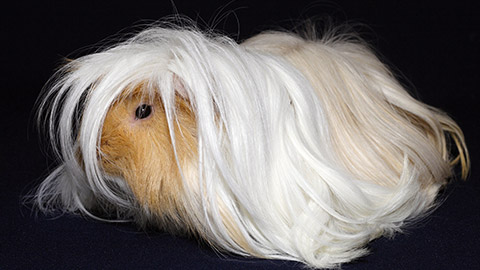
Rough Coat Breeds
As the name suggests these piggies have a rough feeling coat, often with very thick hair, which can be long, short or woolie in texture.
- Teddy Guinea pig
- Rex Guinea pig
- Abyssinian
Hairless Coat Breeds
There are two hairless breeds:
- Skinny pig – has a fine wisps of hair on its feet and nose.
- Baldwin Guinea pig – born with hair which falls off after 3 to 5 days.
Watch: A Quick Guide to Guinea Pig Breeds (7:08 Minutes)
This informative video describes some of the breeds listed.
Guinea Pig Form and Function
Hair type, colour and pattern has resulted primarily from breeding as Guinea pigs have never been a naturally wild animal. However, its teeth follow the same pattern as with other rodents in that they never stop growing and must always have something to chew on. Other features of Guinea pigs include:
- Short limbs because they were originally a ground dwelling animal that lived in burrows.
- A strong, sturdy body (compared to rabbits).
- Can become heat stressed as the ancestor to guinea pigs lived at higher, cooler altitudes.
- Their eyes are located on the sides of the head, allowing them to see both forward and backward to see predators, although they may have trouble seeing directly ahead.
- Their heads are blunt and have small ears, for living in burrows.
- 4 digits (toes) on each front foot and 3 on each hind foot with each toe having a very sharp claw for digging burrows and finding food.
- Their hind legs are longer than their front legs – possibly similar to rabbits who are also burrowing creatures that are adapted to digging holes.
- They have no external tail as they are not climbing or running animals.
Assessment Tip
It can help with learning to present facts like these in an infographic form – there’s something about the combination of words and images that makes facts easier to remember.
- The eyes are positioned in such a way as to allow the guinea pig to see a wide range of angles. This is a survival feature to help them spot predators.
- The short, round, smooth body is designed for moving through small tunnels and burrows. Shorter legs are easier for living in tunnels than longer legs are. A small low body also hides better in grassland, which is their natural habitat.
- The hind legs are longer but only have three toes as they push dirt out of the way, but the front legs are short but have an extra toe to help with digging.
- All toes have sharp claws to help with digging.
- Guinea pig upper and lower front teeth grow continuously due to the hard nature of the food they eat. If they didn’t grow the teeth would wear down and the animal would starve.
Happy guinea pigs will reward their owners with popcorns, whistles and amusing antics as they explore their surroundings. Guinea pigs have a cute feature that humans love: teeth chattering, which can mean that the piggy is happy, or it can mean it is annoyed or scared.
Watch: Hilarious guinea pig popcorning, zoomies, and rumblestrutting! (2:33 mins)
Pre-watch Question
While you watch see if you can identify and name the different coat types, colours and patterns of the guinea pigs featured in the video.
Pre-watch Task
How well did you do with the coat types in the video? Complete the activity below.
Activity
Summary
Pocket pets have very similar coat colours, patterns and types to rabbits, but with some differences in how they are named. How these pets look often has more to do with human breeding selection than functions that would help it in the wild, but they all retain important physical features from their wild ancestors.
Now that we have discussed all of our four-legged companion animals, it’s time to move on to birds. Head on over to Topic 6! He pai aū mahi i tēnei rā.
